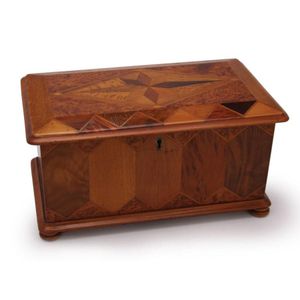18th Century Carved Oak Coffer with Fluted Detail
You must be a subscriber, and be logged in to view price and dealer details.
Subscribe Now to view actual auction price for this item
When you subscribe, you have the option of setting the currency in which to display prices to $Au, $US, $NZ or Stg.
- Oak - Native to Europe and England, oak has been used for joinery, furniture and building since the beginning of the medieval civilisation. It is a pale yellow in colour when freshly cut and darkens with age to a mid brown colour.
Oak as a furniture timber was superceded by walnut in the 17th century, and in the 18th century by mahogany,
Semi-fossilised bog oak is black in colour, and is found in peat bogs where the trees have fallen and been preserved from decay by the bog. It is used for jewellery and small carved trinkets.
Pollard oak is taken from an oak that has been regularly pollarded, that is the upper branches have been removed at the top of the trunk, result that new branches would appear, and over time the top would become ball-like. . When harvested and sawn, the timber displays a continuous surface of knotty circles. The timber was scarce and expensive and was used in more expensive pieces of furniture in the Regency and Victorian periods. - Fluting - A form of decoration found on many pieces of furniture, as well as ceramics, silver and clocks, in which round-bottomed grooves, of varying width and depth, are let into columns, pilasters, legs. As a general rule, flutes are cut in the vertical, though they may follow a turned leg in a spiral pattern. In cross-section, they may be described as a series of 'U' shapes, rising and narrowing at each end of the groove. Fluting is the opposite of reeding, with which fluting is often associated.
- Stile - A cabinetmaker's term that refers to the vertical end members of the framework in a panelled item of furniture. The vertical mid-members are known as muntins.
This item has been included into following indexes:
- coffers - English 162
- oak - trunks 329
Visually similar items

A Tasmanian deed box, huon pine, cedar, blackwood and pine, attributed to Richard Dowling, O'Briens Bridge, circa 1850 13 cm high, 34 cm wide, 23 cm deep

A large William Norrie jewellery box, inlaid with various New Zealand timbers the central star decoration to the lid above a typical Norrie geometric front panel on turned feet. The interior with two removable felt lined trays. Contains two original busine

An inlaid Tasmanian timber box, cedar, blackwood, huon pine, celery pine on huon pine carcass, 19th century, 13 cm high, 28 cm wide, 20 cm deep

English leather steamer trunk, tan leather impressed in crocodile pattern, leather handles to sides, reinforced corners and trim, brass rivets, lock and catch, lined interior, height 60 cm width 58 cm depth 58 cm
